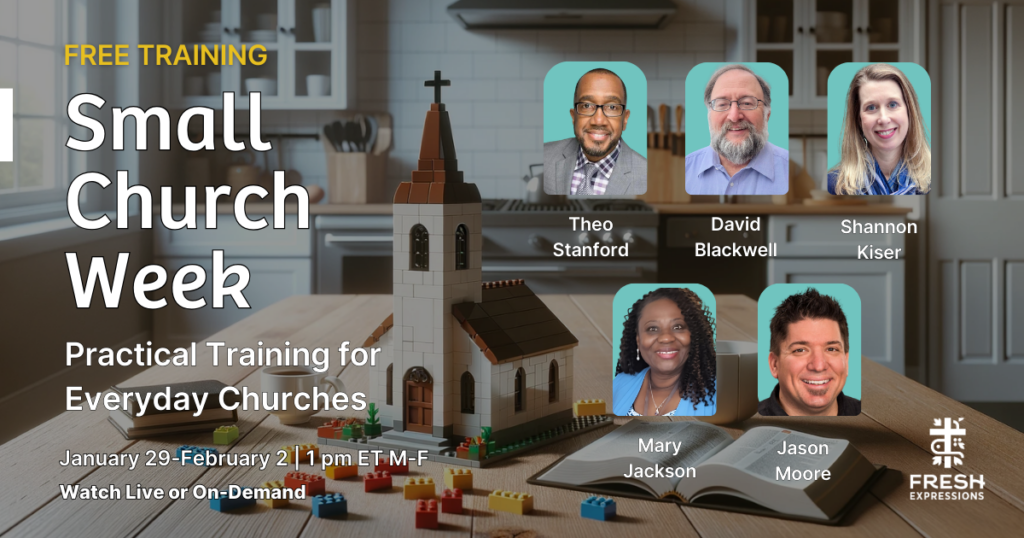Imagine juggling flaming torches while balancing on a unicycle – that’s what Nancy feels like during her multitasking marathon. Meanwhile, Pamela plays a solo game of ‘Where’s Waldo?’ but with volunteers. Navigating the world of small church leadership can be quirky or even chaotic. However, you are not alone on this journey.
This blog post, inspired by input from small church leaders like you, reminds you that the struggle is real, and you are not alone.
The Volunteer Vacuum: Struggling to Find Helper
“I have pastored the same small church for 34 years. There has never been another staff member: no musician, no sexton, etc. There are not enough volunteers on the ground to implement a creative idea.”
– Pamela
“As a pastor, I spend a good bit of time on administrative duties, from purchasing church office supplies to custodial duties.” – Nancy
Small church leaders frequently face the uphill task of inspiring their members to step forward and share the basic church activities necessary to maintain the congregation. This volunteer vacuum also makes implementing new ideas and outreach efforts more difficult.
The Juggling Act: Multitasking Across Roles
“There is not enough time to manage all the many hats I must wear.” – Nancy
“I find it hard to prepare for the Sunday morning sermon, Sunday evening teachings, Wednesday Bible study, and lead changes to help in the growth of the church. I am also a husband, father, and drive school buses for the local school district. So, my time is limited, and I don’t feel I am managing it well.” – Jason
“I find that most people in my church prefer that I serve them as a chaplain rather than lead and equip them as a pastor. This profoundly affects their attitude toward serving the community.”
– [Anonymous]
Small church leaders like Nancy and Jason describe a constant switch between administrative, pastoral, and visionary roles that not only strains their time but also challenges their ability to focus on long-term goals for their church community. The sheer volume of tasks can lead to a sense of being spread too thin, affecting the quality and depth of work in each area. For small church leaders, this juggling act isn’t just about managing time; it’s about nurturing the spiritual well-being of their congregation while also attending to the myriad logistical details of church operations. It’s hard to balance these duties without losing sight of the church’s mission—not to mention your own personal well-being.

The Empty Pew Puzzle: Declining Congregation Numbers
“Small churches that survived Covid never really bounced back.” – David
“I am a new pastor of a church that averages about 11 folks over the age of 50. I need all the help I can get in all areas.” – Hillary
“It’s hard to lead through the grief of the loss of programming, people leaving the community, loss of members, and even the loss of desire for a faith community, all while keeping hope for the future and through change.” – Lucy
Do you ever feel like your church is turning into a ghost town on Sundays? You’re not alone. And the hunt for young families? Sometimes it feels like chasing a mirage. And David is right; things have never really been the same after COVID.
This puzzle of empty pews makes every Sunday both a logistical head-scratcher and a potential source of discouragement. In reality, many reasons for congregational decline have little to do with your congregation. Shifts in our culture have made it harder for people to connect and participate with organizations. Families are busier than ever. If you live in a rural area, you’re also dealing with a general population decline.
The Innovation Impasse: Introducing New Ideas
“The biggest problem I have is keeping people from being depressed because they want to return to the ‘good old days’ of the 1960s and 70s when their Sunday Schools were bursting with children. I want to help them look at the present and contemplate a future.”
– Sue
“It’s hard to find new ministry ideas that people have the time and energy for. I would like our church to think of new ways to support the community, but it feels like they’ve given up.” – Jamie
“I find it difficult to get things going from the idea stage to getting volunteers to help, even if they are excited. It requires a lot of my coaxing and prodding. And I don’t like to be a taskmaster.” – Stephan
Ever tried pitching a new idea at your small church and felt like you accidentally walked into a time machine? It’s like suggesting a new flavor at a vanilla-only ice cream shop. Introducing fresh ideas often feels like navigating a maze blindfolded, especially when balancing them with cherished traditions. And let’s not even get started on the tightrope walk of innovating on a shoestring budget.
Hope Hurdles: Overcoming Despair and Maintaining Hope
“My biggest problem is maintaining a sense of hope for myself and my small, aging congregation.” – Amanda
“I encounter a sense of hopelessness in small churches.” – David
“It’s hard to maintain hope amidst declining numbers and resource constraints.”
– [Anonymous]
The variety of pressures on a small church leader can leave them feeling hopeless, both personally and for their congregation. The small church leader may also feel it is their responsibility to constantly encourage and inspire their congregation, no matter how much it feels like numbers are dwindling and the resources are stretched thin.
Tradition Tug-of-War: Balancing Old and New Practices
“My biggest problem is getting the congregation to let go of ineffective traditional ways and embrace change for the sake of Jesus’ mission.” – Dan
“How to help folks see that just because they loved something or found it meaningful, others might not?” – Ellen
A lot of small church leaders can relate to Dan’s pain as he watches time and energy spent on things that aren’t going anywhere. It’s a delicate dance of respecting traditions while embracing change.
This tug-of-war isn’t just about introducing new practices; it’s about navigating the emotional and historical significance of longstanding traditions.
Small church leaders often find themselves as mediators, striving to blend the old with the new in a way that honors the past while looking towards a dynamic future.
Community Connection Conundrum: Engaging Effectively with the Neighborhood
“Some people seem to be waiting for members to come to them.” – Anonymous
“As a bivocational leader, I have trouble building relationships outside the church.” – [Anonymous]
“Feeling I’m not reaching enough of the people in my community to keep our rural area safe in this broken world.”
– [Anonymous]
“How do we uncover barriers to guests when everyone thinks they are being friendly and welcoming? How to see others as partners, not people trying to take what is theirs?” – Ellen
For church leaders already overwhelmed by the tasks of maintaining their congregation, the idea of engaging with their neighborhood might feel out of reach. It’s easy to understand why some get busy or stuck in a waiting game, hoping the community will just stroll through the church doors. Then there’s the bivocational leaders, juggling jobs and trying to find time to connect with neighbors.
It’s not just a time management problem. Ellen brings up another point: churches aren’t always as welcoming as they would like to be. Even the most open-minded visitors might feel like they are just being recruited. Making new connections in the community will mean making time and space to listen to what is happening in the lives of those around us.
Begin with Listening
So, what is a small church leader to do? Like the disciples in the stormy sea (Mark 4:35-41), small church leaders might feel overwhelmed. While there are no easy solutions, the Fresh Expressions approach to mission and ministry is designed to fit these realities.
Fresh Expressions is both inspired by the early church and informed by centuries of Christian practice. It is guided by the early church’s adaptability seen in Acts 2:42-47, where a Jesus-inspired community was formed by normal people and fit into their everyday lives. It also mirrors Paul’s strategy of becoming “all things to all people” (1 Corinthians 9:22) by guiding church leaders to listen to their communities and explore new approaches that resonate with modern life. At the same time, it seeks to bring out the best in our traditions and institutions.
To begin, a small church leader listens to the heart of their congregation, the needs of the community, and their sense of the Holy Spirit’s guidance. While it may be that some things will need to change, a posture of listening can make the whole process of change and experimentation feel calm and even empowering.
This will, in time, help a small church leader and their congregation discover new ways to connect with people in their everyday spaces. Jesus sent his disciples into the lives and even homes of their neighbors in Luke 10. When leading by listening, small churches can begin to build genuine relationships, fostering a sense of community among those who need it most in their neighborhoods and towns. This may or may not revitalize a congregation, but it will spread God’s love and offer a tangible example of the Gospel.


